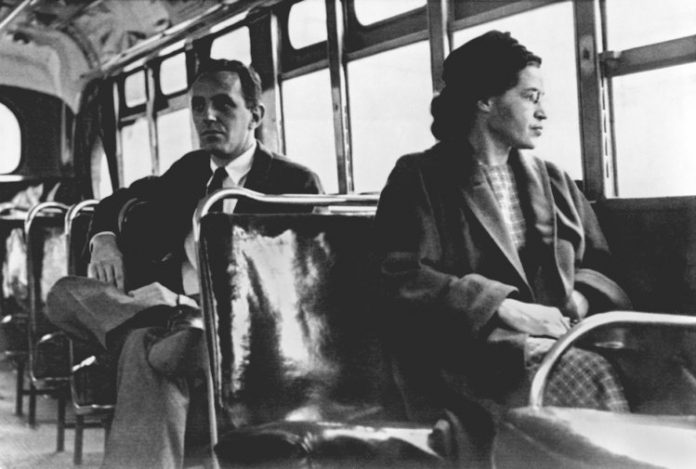It’s one of the most famous moments in modern American civil rights history: On a chilly December evening in 1955, on a busy street in the capital of Alabama, a 42-year-old seamstress boarded a segregated city bus to return home after a long day of work, taking a seat near the middle, just behind the front “white” section. At the next stop, more passengers got on. When every seat in the white section was taken, the bus driver ordered the black passengers in the middle row to stand so a white man could sit. The seamstress refused.
Rosa Parks’ defiance of an unfair segregation law, which required black passengers to defer to any white person who needed a seat by giving up their own, forever changed race relations in America. She was not the first African American to do this. In fact, two other black women had previously been arrested on buses in Montgomery and were considered by civil rights advocates as potential touchpoints for challenging the law. However, both women were rejected because community leaders felt they would not gain support. Rosa Parks, with her flawless character, quiet strength, and moral fortitude, was seen as an ideal candidate. And those community leaders were right: Rosa Parks’ subsequent arrest by local police sparked a collective and sustained community response. As one young Montgomery resident said at the time, city officials had “messed with the wrong one now.” The boycott of public buses by blacks in Montgomery lasted 381 days, marking the country’s first large-scale demonstration against segregation.
The boycott ultimately led the U.S. Supreme Court to outlaw racial segregation on public buses in Alabama. It also spurred more non-violent protests in other cities and catapulted a young Baptist minister named Martin Luther King, Jr., into prominence as a leader of the civil rights movement. The movement and the laws it prompted, including the Civil Rights Act of 1964 and the Voting Rights Act of 1965, are one of the greatest social revolutions in modern American history.
President Obama, among many others, credits Rosa Parks’ “singular act of disobedience” with launching a civil rights movement that lasts to this day. “Rosa Parks tells us there’s always something we can do,” he said during a 2013 ceremony to unveil a statue of Parks at the U.S. Capitol, where she is honored alongside past presidents, members of Congress, and military leaders. “She tells us that we all have responsibilities, to ourselves and to one another.”
Much has been written and celebrated about Rosa Parks’ courage. Type both her name and that enviable attribute into Google and you’ll turn up more than 500,000 sources—everything from biographies (Courageous Citizen, A Life of Courage, and The Courage to Make a Difference, to name a few) to TV and film documentaries and historical and journalistic accounts. When the U.S. Postal Service issued a stamp in her honor in 2013, on what would have been her 100th birthday (an event that took place at The Henry Ford as part of a National Day of Courage celebration), the design prominently featured “courage” alongside her portrait.
If we travel back in time to the December evening in 1955 when Rosa Parks boarded that city bus, we can begin to glimpse just why her courage was so extraordinary. We know from her account of the event that she made her defiant decision in an instant. It took tremendous courage. But it took even more courage for her to stand by her decision in the minutes, days, and years that followed.
To understand why, board bus No. 2857 assigned to the Cleveland Avenue route that December night. That very bus, painstakingly restored, is now parked inside Henry Ford Museum, and open to everyone. Enter through the front door and picture the scene from years ago: Most of the front 10 seats reserved for whites are occupied, as are the 10 seats at the rear marked with a sign for the “colored” section. See the overhead light shining down on the green-cushioned seat in the middle? Settle yourself here, just as Rosa Parks did.
We know from many accounts that Rosa Parks recognized the bus driver—he had humiliated her and other black riders over the years. Twelve years earlier, in fact, she’d even had a personal confrontation with him when he demanded that she exit the bus and board through the rear door (on that occasion, she had relented; when she stepped off, the driver promptly sped away before she could board in the rear). She also knew that this man, who threatened to have her arrested, carried a pistol in his holster. She was aware of recent racial atrocities, including the mistreatment of another black woman, Claudette Colvin, for not giving up her seat, and the death earlier that summer of 14-year-old Emmett Till from a lynching.
Let your imagination revisit the moments that unfolded as the flustered bus driver pointedly asked her, “Are you going to stand up?”
As one of her biographers, Douglas Brinkley, observed, Rosa Parks in that moment felt fearless, bold, and serene. She looked straight at the bus driver and said, “No.”
Three other black riders sat in the same row, one next to Rosa Parks, the other two across the aisle. When the bus driver again demanded that all four passengers give up their seats, the three other riders reluctantly got up. All the black riders were now at the back, all the whites at the front. Rosa Parks sat between them, a brave solitary figure marking the painful boundary between races. “As I sat there, I tried not to think about what might happen,” she wrote in her autobiography. “I knew that anything was possible. I could be manhandled or beaten. I could be arrested. People have asked me if it occurred to me then that I could be the test case the NAACP [National Association for the Advancement of Colored People] had been looking for. I did not think about that at all. In fact if I had let myself think too deeply about what might happen to me, I might have gotten off the bus.”
In that moment between “might have” and “didn’t,” her courage began to transform into something extraordinary. As Brinkley observed, “A lifetime’s education in justice—from her grandfather’s nightly vigils to the murder of Emmett Till—had strengthened her resolve to act when the time came. What arose in Parks on that fateful evening was her belief in what Dr. Martin Luther King, Jr., often said: that ‘some of us must bear the burden of trying to save the soul of America.’” Rosa Parks later put it this way: “When I made that decision, I knew that I had the strength of my ancestors with me.”
Tracing the Long History of Racial Inequality
“To understand the real risks Rosa Parks faced in refusing to give up her seat,” says Donna Braden, Curator of Public Life at The Henry Ford, “we must explore the nature of segregated travel in the ‘Jim Crow South.'” “Jim Crow” laws enforcing racial segregation in southern U.S. states were first enacted in the 1880s by angry and resentful whites against freed African Americans. Favoring whites and repressing blacks became an institutionalized form of inequality. And, by 1896, with the Plessy v. Ferguson case, the U.S. Supreme Court ruled that states had the legal power to require segregation between blacks and whites.













